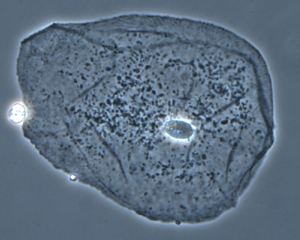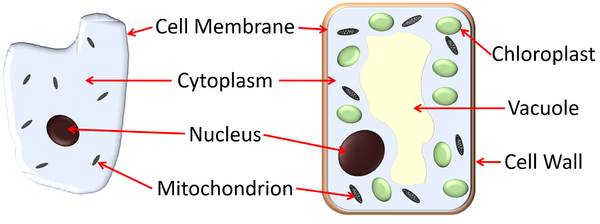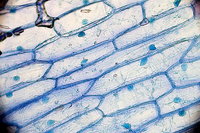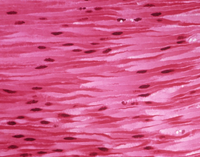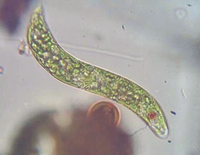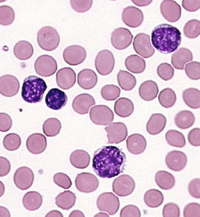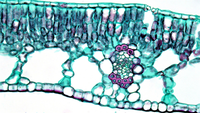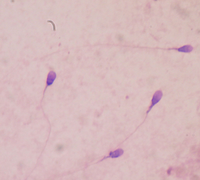Difference between revisions of "Cell (Biology)"
(→Examples) |
|||
| Line 8: | Line 8: | ||
: Every living thing is made of '''cells''' but not all '''cells''' are the same. | : Every living thing is made of '''cells''' but not all '''cells''' are the same. | ||
'''Cells''' are made of smaller parts: | '''Cells''' are made of smaller parts: | ||
| − | *[[Cell Membrane]] - Controls what goes in and out of a [[Cell (Biology)|cell]]. | + | :*[[Cell Membrane]] - Controls what goes in and out of a [[Cell (Biology)|cell]]. |
| − | *[[Cell Wall]] - Protects the [[Cell (Biology)|cell]] and allows them to keep their shape. | + | :*[[Cell Wall]] - Protects the [[Cell (Biology)|cell]] and allows them to keep their shape. |
| − | *[[Chloroplast]]s - Produces food for a [[Cell (Biology)|cell]] using [[photosynthesis]]. | + | :*[[Chloroplast]]s - Produces food for a [[Cell (Biology)|cell]] using [[photosynthesis]]. |
| − | *[[Cytoplasm]] - A jelly-like [[substance]] where [[Chemical Reaction|chemical reactions]] take place. | + | :*[[Cytoplasm]] - A jelly-like [[substance]] where [[Chemical Reaction|chemical reactions]] take place. |
| − | *[[Mitochondria]] - Where [[respiration]] takes place. | + | :*[[Mitochondria]] - Where [[respiration]] takes place. |
| − | *[[Nucleus]] - Controls the activities of the [[Cell (Biology)|cell]] and contains the [[DNA]]. | + | :*[[Nucleus]] - Controls the activities of the [[Cell (Biology)|cell]] and contains the [[DNA]]. |
| − | *[[Permanent Vacuole]] - Stores [[Cell (Biology)|cell]] sap. | + | :*[[Permanent Vacuole]] - Stores [[Cell (Biology)|cell]] sap. |
: [[Plant Cell]]s and [[Animal Cell]]s made of some different parts. | : [[Plant Cell]]s and [[Animal Cell]]s made of some different parts. | ||
Revision as of 09:58, 7 June 2019
Contents
Key Stage 3
Meaning
A cell is the smallest living part of all living things.
About Cells
- Cells cannot be seen with the naked eye. You need a microscope to see them.
- Every living thing is made of cells but not all cells are the same.
Cells are made of smaller parts:
- Cell Membrane - Controls what goes in and out of a cell.
- Cell Wall - Protects the cell and allows them to keep their shape.
- Chloroplasts - Produces food for a cell using photosynthesis.
- Cytoplasm - A jelly-like substance where chemical reactions take place.
- Mitochondria - Where respiration takes place.
- Nucleus - Controls the activities of the cell and contains the DNA.
- Permanent Vacuole - Stores cell sap.
- Plant Cells and Animal Cells made of some different parts.
- All cells have cytoplasm and a cell membrane
- Both Animal Cells and Plant Cells have a nucleus and mitochondria.
- Only Plant Cells have chloroplasts, a cell wall and a permanent vacuole
| An Animal Cell on the left and a Plant Cell on the right. |
Examples
| The cells in an onion stained blue. | Muscle cells stained pink. | A single celled organism called a Euglena that is green because of the chlorophyll inside. |
| 4 White blood cells stained purple surrounded by several red blood cells. | Several different types of plant cell found in a leaf. | Sperm cells stained purple and shown under a microscope. |
Key Stage 4
Meaning
A cell is the smallest living part of an organism.
About Cells
- Cells can be divided into two main groups Eukaryotic Cells, which contain membrane bound organelles, and Prokaryotic Cells which do not contain membrane bound organelles.
About Cells
- Cells cannot be seen with the naked eye. You need a microscope to see them.
- Every living thing is made of cells but not all cells are the same.
Cells are made of smaller parts:
- Cell Membrane - A selectively permeable membrane which controls what goes in and out of a cell.
- Cell Wall - Protects the cell and allows them to keep their shape.
- Chloroplasts - Produces food for a cell using photosynthesis.
- Cytoplasm - A jelly-like substance where metabolic processes take place.
- Mitochondria - Where respiration takes place.
- Nucleus - Controls the activities of the cell and contains the DNA.
- Permanent Vacuole - Stores cell sap.
- Ribosomes - The areas of protein synthesis in the cells.
- Plant Cells and Animal Cells made of some different parts.
- All cells have cytoplasm and a cell membrane
- Both Animal Cells and Plant Cells have a nucleus and mitochondria.
- Only Plant Cells have chloroplasts, a cell wall and a permanent vacuole
| An Animal Cell on the left and a Plant Cell on the right. |
Examples
| The cells in an onion stained blue. | Muscle cells stained pink. | A unicellular organism called a Euglena that is green because of the chlorophyll inside. |
| 4 White blood cells stained purple surrounded by several red blood cells. | Several different types of plant cell found in a leaf. | Sperm cells stained purple and shown under a microscope. |
